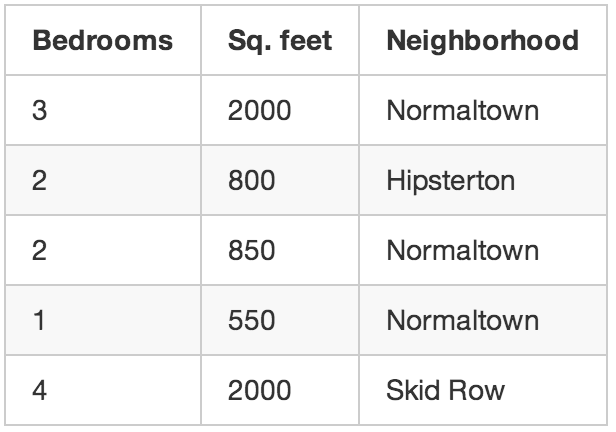The Beginner’s self-starter guide to ML
Two kinds of Machine Learning Algorithms
You can think of machine learning algorithms as falling into one of two main categories — supervised learning and unsupervised learning. The difference is simple, but really important.
Supervised Learning
Let’s say you are a real estate agent. Your business is growing, so you hire a bunch of new trainee agents to help you out. But there’s a problem — you can glance at a house and have a pretty good idea of what a house is worth, but your trainees don’t have your experience so they don’t know how to price their houses.
To help your trainees (and maybe free yourself up for a vacation), you decide to write a little app that can estimate the value of a house in your area based on it’s size, neighborhood, etc, and what similar houses have sold for.
So you write down every time someone sells a house in your city for 3 months. For each house, you write down a bunch of details — number of bedrooms, size in square feet, neighborhood, etc. But most importantly, you write down the final sale price:


Using that training data, we want to create a program that can estimate how much any other house in your area is worth:


This is called supervised learning. You knew how much each house sold for, so in other words, you knew the answer to the problem and could work backwards from there to figure out the logic.
To build your app, you feed your training data about each house into your machine learning algorithm. The algorithm is trying to figure out what kind of math needs to be done to make the numbers work out.
This kind of like having the answer key to a math test with all the arithmetic symbols erased:


From this, can you figure out what kind of math problems were on the test? You know you are supposed to “do something” with the numbers on the left to get each answer on the right.
In supervised learning, you are letting the computer work out that relationship for you. And once you know what math was required to solve this specific set of problems, you could answer to any other problem of the same type!
Unsupervised Learning
Let’s go back to our original example with the real estate agent. What if you didn’t know the sale price for each house? Even if all you know is the size, location, etc of each house, it turns out you can still do some really cool stuff. This is called unsupervised learning.


This is kind of like someone giving you a list of numbers on a sheet of paper and saying “I don’t really know what these numbers mean but maybe you can figure out if there is a pattern or grouping or something — good luck!”
So what could do with this data? For starters, you could have an algorithm that automatically identified different market segments in your data. Maybe you’d find out that home buyers in the neighborhood near the local college really like small houses with lots of bedrooms, but home buyers in the suburbs prefer 3-bedroom houses with lots of square footage. Knowing about these different kinds of customers could help direct your marketing efforts.
Another cool thing you could do is automatically identify any outlier houses that were way different than everything else. Maybe those outlier houses are giant mansions and you can focus your best sales people on those areas because they have bigger commissions.
Supervised learning is what we’ll focus on for the rest of this post, but that’s not because unsupervised learning is any less useful or interesting. In fact, unsupervised learning is becoming increasingly important as the algorithms get better because it can be used without having to label the data with the correct answer.
Side note: There are lots of other types of machine learning algorithms. But this is a pretty good place to start.
